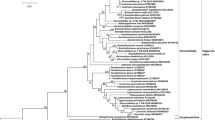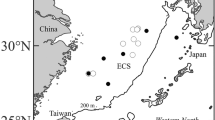Abstract
The Japanese Spanish mackerel (Scomberomorus niphonius; Perciformes: Scombridae) is widely distributed in the continental shelves of the northwestern Pacific Ocean around Japan, Sea of Japan, and East China Sea. In the present study, small, spindle-shaped myxosporean plasmodia (0.15–0.53 mm by 0.04–0.13 mm) were frequently encountered in the myofiber of trunk muscles of two Japanese Spanish mackerels; one fished in the Sea of Japan off western Japan and the other in the northwestern Pacific Ocean off southern Japan in the autumn of 2016. Isolated myxospores of Kudoa konishiae n. sp. (Myxosporea: Multivalvulida) from these two fish were stellate with six equal shell valves and polar capsules, 8.1–9.7 μm in width, 7.1–8.8 μm in thickness, and 7.1–8.8 μm in length. The polar capsules were teardrop-shaped, 2.7–4.7 μm by 1.2–2.5 μm. The lateral view of spores revealed a drawstring-pouch shape. The nucleotide sequences of the 18S and 28S ribosomal RNA gene (rDNA) were distinct from any recorded species. Phylogenetic trees demonstrated a close relationship of the present new species with Kudoa spp. with stellate spores with five or more shell valves/polar capsules, recorded in scombrid fishes. To clarify the phylogenetic relationships between three closely related species, i.e., Kudoa konishiae n. sp., Kudoa hexapunctata, and Kudoa neothunni, three mitochondrial DNA genes (cytochrome c oxidase subunit 1 gene (cox-1) and the small and large subunits of the ribosomal RNA gene (rns-rnl)) of two isolates of the new species, six isolates of K. hexapunctata, and 13 isolates of K. neothunni were sequenced. The interspecific and intraspecific variations of the newly obtained cox-1 and rns-rnl nucleotide sequences of K. hexapunctata, K. neothunni, and K. konishiae n. sp. were clarified for the first time.





Similar content being viewed by others
References
Adlard RD, Bryant MS, Whipps CM, Kent ML (2005) Multivalvulid myxozoans from eastern Australia: three new species of Kudoa from scombrid and labrid fishes of the Great Barrier Reef, Queensland, Australia. J Parasitol 91(5):1138–1142. https://doi.org/10.1645/GE-368R.1
Alama-Bermejo G, Jirků M, Kodádková A, Pecková H, Fiala I, Holzer AS (2016) Species complexes and phylogenetic lineages of Hoferellus (Myxozoa, Cnidaria) including revision of the genus: a problematic case for taxonomy. Parasites Vectors 9(1):13. https://doi.org/10.1186/s13071-015-1265-8
Azevedo C, Rocha S, Motos P, Motos E, Oliveira E, Al-Quraishy S, Csal G (2014) Morphological and phlogeny of Henneguya jocu n. sp. (Myxosporea: Myxobolidae), infecting the gills of the marine fish Lutjanus jocu. Eur J Protistol 50:185–193
Bartošová-Sojková P, Hrabcová M, Pecková H, Patra S, Kodádková A, Jurajda P, Tyml T, Holzer AS (2014) Hidden diversity and evolutionary trends in malacosporean parasites (Cnidaria: Myxozoa) identified using molecular phylogenetics. Int J Parasitol 44(8):565–577. https://doi.org/10.1016/j.ijpara.2014.04.005
Burger MAA, Adlard RD (2010a) Four new species of Kudoa Meglitsch, 1947 (Myxosporea: Multivalvulida) from Australia with recommendations for species descriptions in the Kudoidae. Parasitology 137(05):793–814. https://doi.org/10.1017/S0031182009991557
Burger MAA, Adlard RD (2010b) Phenotypic variation in a significant spore character in Kudoa (Myxosporea: Multivalvulida) species infecting brain tissue. Parasitology 137(12):1759–1772. https://doi.org/10.1017/S0031182010000673
Burger MAA, Adlard RD (2011) Low host specificity in the Kudoidae (Myxosporea: Multivalvulida) including seventeen new host records for Kudoa thalassomi. Folia Parasitol 58(1):1–16. https://doi.org/10.14411/fp.2011.001
Burger MAA, Cribb TH, Adlard RD (2007) Patterns of relatedness in the Kudoidae with descriptions of Kudoa chaetodoni n. sp. and K. lethrini n. sp. (Myxosporea: Multivalvulida). Parasitology 134(05):669–681. https://doi.org/10.1017/S0031182006001995
Burger MA, Brames AC, Adlard RD (2008) Wildlife as reservoirs for parasites infecting commercial species: host specificity and redescription of Kudoa amamiensis from teleost fish in Australia. J Fish Dis 31(11):835–844. https://doi.org/10.1111/j.1365-2761.2008.00958.x
Diamant A, Ucko M, Paperna I, Colorni A, Lipshitz A (2005) Kudoa iwatai (Myxosporea: Multivalvulida) in wild and cultured fish in the red sea: redescription and molecular phylogeny. J Parasitol 91:1175–1189
Eiras JC, Lima JTAX, Cruz CF, Saraiva A (2014) A note on the infection of Scomberomorus brasiliensis (Osteichthyes, Scombridae) by Kudoa sp. (Myxozoa: Multivalvulida). Braz J Biol 73 (suppl) 74(3 suppl 1):S164–S166. https://doi.org/10.1590/1519-6984.23712
Eiras JC, Saravia A, Cruz C (2014) Synopsis of the species of Kudoa Meglitsch, 1947 (Myxozoa: Myxosporea: Multivalvulida). Syst Parasitol 87: 153–180
Fiala I, Hlavničková M, Kodádková A, Freeman MA, Bartošová-Sojková P, Atkinson SD (2015) Evolutionary origin of Ceratonova shasta and phylogeny of the marine myxosporean lineage. Mol Phylogenet Evol 86:75–89
Grossel GW, Dykova I, Handlinger J, Munday BL (2003) Pentacapsula neurophila sp. n. (Multivalvulida) from the central nervous system of striped trumpeter, Latris lineata (Forster). J Fish Dis 26(6):315–320. https://doi.org/10.1046/j.1365-2761.2003.00459.x
Grossel GW, Handlinger J, Battaglene S, Munday BL (2005) Diagnostic polymerase chain reaction assay to detect Kudoa neurophila (Myxozoa: Multivalvulida) in a marine finfish hatchery. Dis Aquat Org 64(2):141–149. https://doi.org/10.3354/dao064141
Gunter NL, Cribb TH, Whipps CM, Adlard RD (2006) Characterization of Kudoa monodactyli n. sp. (Myxosporea: Multivalvulida) from the muscle of Monodactylus argenteus (Teleostei: Monodactylidae) from Moreton Bay, Queensland, Australia. J Eukaryot Microbiol 53(5):374–378. https://doi.org/10.1111/j.1550-7408.2006.00115.x
Heiniger H, Cribb TH, Adlard RD (2013) Intra-specific variation of Kudoa spp. (Myxosporea: Multivalvulida) from apogonid fishes (Perciformes), including the description of two new species, K. cheilodipteri n. sp. and K. cookii n. sp., from Australian waters. Syst Parasitol 84(3):193–215. https://doi.org/10.1007/s11230-012-9400-9
Iversen ES, Van Meter NN (1967) A new myxosporidian (Sporozoa) infecting the Spanish mackerel. Bull Mar Sci 17:268–273
Kasai A, Li Y-C, Setsuda A, Mafie E, Sato H (2015) Genetic characterization of Kudoa iwatai and Kudoa trachuri in commercial marine fish (Platycephalus sp. and Trachurus japonicus) for human consumption. Jpn J Vet Parasitol 14:22–30
Kasai A, Li Y-C, Mafie E, Sato H (2016) New host records of monacanthid fish for three Kudoa spp. (K. septempunctata, K. thyrsites, and K. shiomitsui) prevalent in the olive flounder (Paralichthys olivaceus), with the description of K. parathyrsites n. sp. from a black scraper (Thamnaconus modestus). Parasitol Res 115(7):2741–2755. https://doi.org/10.1007/s00436-016-5023-4
Kasai A, Setsuda A, Sato H (2017) Morphological and genetic characterization of Kudoa whippsi (Myxosporea: Multivalvulida) from Cheilodactylus zonatus in the western Pacific Ocean off Japan, and two new Kudoa spp. (K. akihitoi n. sp. and K. empressmichikoae n. sp.) from Acanthogobius hasta in the Sea of Ariake, Japan. Parasitol Res 116:647–659
Kasai A, Tsuduki H, Jimenez LA, Li Y-C, Tanaka S, Sato H (2017) Incidence of three Kudoa spp., K. neothunni, K. hexapunctata, and K. thunni (Myxosporea: Multivalvulida), in Thunnus tunas distributed in the western Pacific Ocean. Parasitol Res 116(4):1137–1150. https://doi.org/10.1007/s00436-016-5369-7
Kato E, Kasai A, Tomochi H, Li Y-C, Sato H (2017) Four Myxobolus spp. (Myxosporea: Bivalvulida) from the gill lamellae of common carp (Cyprinus carpio) and Japanese silver crucian carp (Carassius langsdorfii) in the western part of Japan, with the description of three new species (M. tanakai n. sp., M. paratoyamai n. sp., and M. ginbuna n. sp.) Parasitol Res 116:2427–2441
Li Y-C, Sato H, Tanaka S, Ohnishi T, Kamata Y, Sugita-Konishi Y (2013) Characterization of the ribosomal RNA gene of Kudoa neothunni (Myxosporea: Multivalvulida) in tunas (Thunnus spp.) and Kudoa scomberi n. sp. in a chub mackerel (Scomber japonicus). Parasitol Res 112(5):1991–2003. https://doi.org/10.1007/s00436-013-3357-8
Lom J, Arthur JR (1989) A guideline for the preparation of species descriptions in Myxosporea. J Fish Dis 12(2):151–156. https://doi.org/10.1111/j.1365-2761.1989.tb00287.x
Lom J, Dyková I (2006) Myxozoan genera: definition and notes on taxonomy, life-cycle terminology and pathogenic species. Folia Parasitol 53(1):1–36. https://doi.org/10.14411/fp.2006.001
Matsukane Y, Sato H, Tanaka S, Kamata Y, Sugita-Konishi Y (2010) Kudoa septempunctata n. sp. (Myxosporea: Multivalvulida) from an aquacultured olive flounder (Paralichthys olivaceus) imported from Korea. Parasitol Res 107(4):865–872. https://doi.org/10.1007/s00436-010-1941-8
Meng F, Yokoyama H, Shirakashi S, Grabner D, Ogawa K, Ishimaru K, Sawada Y, Murata O (2011) Kudoa prunusi n. sp. (Myxozoa: Multivalvulida) from the brain of Pacific bluefin tuna Thunnus orientalis (Temminck & Schlegel, 1844) cultured in Japan. Parasitol Int 60(1):90–96. https://doi.org/10.1016/j.parint.2010.11.006
Miller TL, Adlard RD (2012) Brain infecting kudoids of Australia’s coral reefs, including a description of Kudoa lemniscati n. sp. (Myxosporea: Kudoidae) from Lutjanus lemniscatus (Perciformes: Lutjanidae) off Ningaloo Reef, western Australia. Parasitol Int 61(2):333–342. https://doi.org/10.1016/j.parint.2012.01.002
Miller TL, Adlard RD (2013) Unicapsula species (Myxosporea: Trilosporidae) of Australian marine fishes, including the description of Unicapsula andersenae n. sp. in five teleost families off Queensland, Australia. Parasitol Res 112(8):2945–2957. https://doi.org/10.1007/s00436-013-3467-3
Moran JDW, Whitaker DJ, Kent ML (1999) A review of the myxosporean genus Kudoa Meglitsch, 1947, and its impact on the international aquaculture industry and commercial fisheries. Aquaculture 172(1-2):163–196. https://doi.org/10.1016/S0044-8486(98)00437-2
Sato H, Kasai A (2016) Kudoa species (Myxozoa: Myxosporea: Multivalvulida) recorded in Japan or its surrounding natural waters (1930-2016). Jpn J Vet Parasitol 15: 111–138 (in Japanese with English summary)
Sekiya M, Setsuda A, Sato H, Song K, Han J-K, Kim G-J, Yeo IK (2016) Enteromyxum leei (Myxosporea: Bibalvulida) as the cause of myxosporean emaciation disease of farmed olive flounders (Paralichthys olivaceus) and a turbot (Scophthalmus maximus) on Jeju Island, Korea. Parasitol Res 115(11):4229–4237. https://doi.org/10.1007/s00436-016-5200-5
Shirakashi S, Yamane K, Ishitani H, Yanagida T, Yokoyama H (2014) First report of Kudoa species in the somatic muscle of the Japanese parrotfish Calotomus japonicus (Scaridae) and a description of Kudoa igami n. sp. (Myxozoa: Multivalvulida). Parasitol Res 113:2515–2524
Shui B-N, Han Z-Q, Gao T-X, Miao Z-Q, Yanagimoto T (2009) Mitochondrial DNA variation in the East China Sea and Yellow Sea populations of Japanese Spanish mackerel Scomberomorus niphonius. Fish Sci 75(3):593–600. https://doi.org/10.1007/s12562-009-0083-3
Takeuchi F, Sekizuka T, Ogasawara Y, Yokoyama H, KamikawaR IY, Nozaki T, Sugita-Konishi Y, Ohnishi T, Kuroda M (2015) The mitochondrial genomes of a myxozoan genus Kudoa are extremely divergent in Metazoa. PLoS One 10(7):e0132030. https://doi.org/10.1371/journal.pone.0132030
Takeuchi F, Ogasawara Y, Kato K, Sekizuka T, Nozaki T, Sugita-Konishi Y, Ohnishi T, Kuroda M (2016) Genetic variants of Kudoa septempunctata (Myxozoa: Multivalvulida), a flounder parasite causing foodborne disease. J Fish Dis 39(6):667–672. https://doi.org/10.1111/jfd.12395
Thompson JD, Higgins DG, Gibson TJ (1994) CLUSTAL W: improving the sensitivity of progressive multiple sequence alignment through sequence weighting, position-specific gap penalties and weight matrix choice. Nucleic Acids Res 22(22):4673–4680. https://doi.org/10.1093/nar/22.22.4673
Tomochi H, Li YC, Tran BT, Yanagida T, Sato H (2014) Three Unicapsula species (Myxosporea: Trilosporidae) of Asian marine fishes, including the description of Unicapsula setoensis n. sp. in the yellowfin goby (Acanthogobius flavimanus) from the Inland Sea of Japan. Parasitol Res 113(10):3807–3816. https://doi.org/10.1007/s00436-014-4048-9
Untergasser A, Cutcutache I, Koressaar T, Ye J, Faircloth BC, Remm M, Rozen SG (2012) Primer3—new capabilities and interfaces. Nucleic Acids Res 40(15):e115. https://doi.org/10.1093/nar/gks596
Whipps CM, Kent ML (2006) Phylogeography of the cosmopolitan marine parasite Kudoa thyrsites (Myxozoa: Myxosporea). J Eukaryot Microbiol 53(5):364–373. https://doi.org/10.1111/j.1550-7408.2006.00114.x
Whipps CM, Adlard RD, Bryant MS, Kent ML (2003a) Two unusual myxozoans, Kudoa quadricornis n. sp. (Multivalvulida) from the muscle of goldspotted trevally (Carangoides fulvoguttatus) and Kudoa permulticapsula n. sp. (Myltivalvulida) from the muscle of Spanish mackerel (Scomberomorus commerson) from the Great Barrier Reef, Australia. J Parasitol 89(1):168–173.
Whipps CM, Adlard RD, Bryant MS, Lester RJG, Findlay V, Kent ML (2003b) First report of three Kudoa species from eastern Australia: Kudoa thyrsites from mahi mahi (Coryphaena hippurus), Kudoa amamiensis and Kudoa minithyrsites n. sp. from sweeper (Pempheris ypsilychnus). J Eukaryot Microbiol 50(3):215–219. https://doi.org/10.1111/j.1550-7408.2003.tb00120.x
Whipps CM, Grossel G, Adlard RD, Yokoyama H, Bryant MS, Munday BL, Kent ML (2004) Phylogeny of the Multivalvulidae (Myxozoa: Myxosporea) based on comparative ribosomal DNA sequence analysis. J Parasitol 90(3):618–622. https://doi.org/10.1645/GE-153R
Yokoyama H, Itoh N (2005) Two multivalvulid myxozoans causing postmortem myoliquefaction: Kudoa megacapsula n. sp. from red barracuda (Sphyraena pinguis) and Kudoa thyrsites from splendid alfonso (Beryx splendens). J Parasitol 91(5):1132–1137. https://doi.org/10.1645/GE-548R.1
Yokoyama H, Whipps CM, Kent M, Mizuno K, Kawakami H (2004) Kudoa thyrsites from Japanese flounder and Kudoa lateolabracis n. sp. from Chinese sea bass: causative myxozoans of post-mortem myoliquefaction. Fish Parasitol 39:79–85
Yokoyama H, Suzuki J, Shirakashi S (2014) Kudoa hexapunctata n. sp. (Myxozoa: Multivalvulida) from the somatic muscle of Pacific bluefin tuna Thunnus orientalis and re-description of K. neothunni in yellowfin tuna T. albacares. Parasitol Int 63(4):571–579. https://doi.org/10.1016/j.parint.2014.03.006
Funding
This study was supported in part by Grant-in-Aid for Scientific Research 2017 from The Towa Foundation for Food Science and Research (HS), and JSPS KAKENHI Grant Number 15K07722.
Author information
Authors and Affiliations
Corresponding author
Additional information
Section Editor: Christopher Whipps
Rights and permissions
About this article
Cite this article
Sakai, H., Kato, E., Sakaguchi, S. et al. Morphological and molecular genetic characterization of Kudoa konishiae n. sp. (Myxosporea: Multivalvulida) in the muscle of Japanese Spanish mackerel (Scomberomorus niphonius). Parasitol Res 117, 893–904 (2018). https://doi.org/10.1007/s00436-018-5770-5
Received:
Accepted:
Published:
Issue Date:
DOI: https://doi.org/10.1007/s00436-018-5770-5




